Spring and Summer 2025
THIS SECTION IS NOW ACTIVE FOR THE NEXT FEW WEEKS IN SEPTEMBER
This section will record and comment on observations of emerging and hopefully flourishing nature this Summer. The warm weather in March will probably fast track some species to get ahead and may hold others back. It will be interesting to see which species of both plant and animals our very wet Winter, dry Spring and hot dry Summer will benefit or undermine most.
Questions I will be looking at answering from this Summer and Autumn?
There is more photographic and observational evidence to follow.
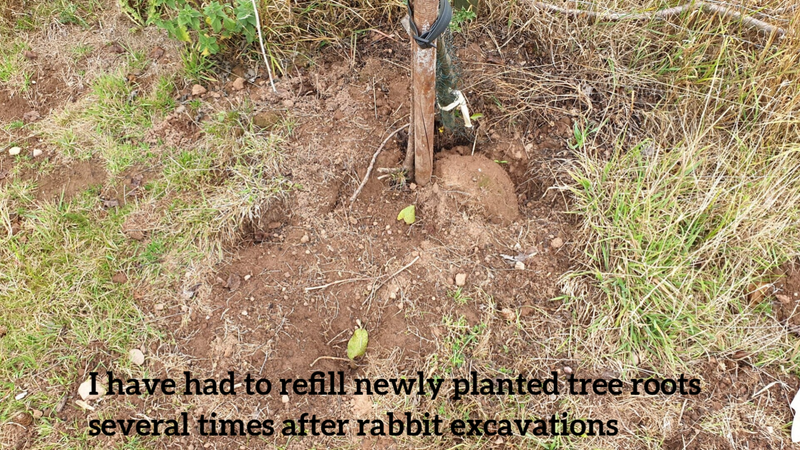

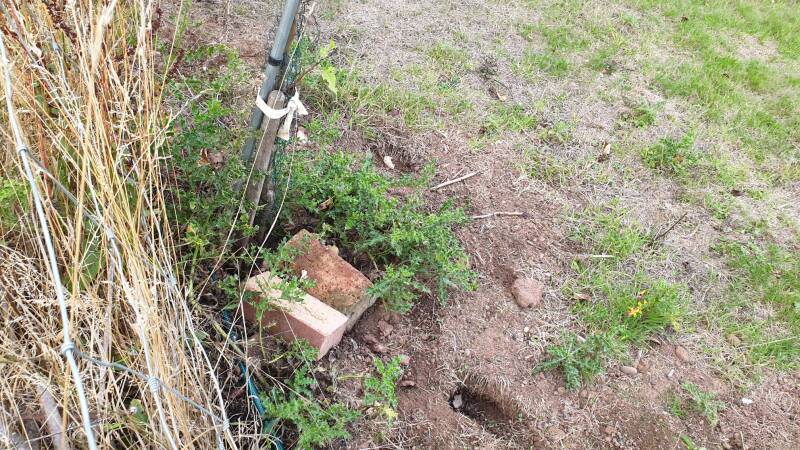
1. Have moles, rabbits and other mammals contributed to soil health in the drought conditions this year?
Moles have only been obviously active where some watering has taken place. Recent heavy rain in early September has softened the ground so this can only be evaluated over the coming weeks. Its difficult to count moles, but the soil mounds where tunnels are can indicate their presence or shallow tunnels see below left.
LEFT here rabbits keep digging around the base of newly planted trees where the soil is softer. Problematic as in the drought the roots can dry out.
Below These potential rabbit warrens were never finished. I assume that the clay underlayer was to difficult to penetrate.

LEFT Unsightly though this is it was a quick fix to stop roots being dug up. The disturbed soil also provided thistle the opportunity to establish themselves.
Traditionally moles and rabbits are considered pests but there is no doubt they are constantly turning the soil over. Protecting the bark of young trees is essential to stop rabbits killing the tree by eating the bark at the base especially in Winter.
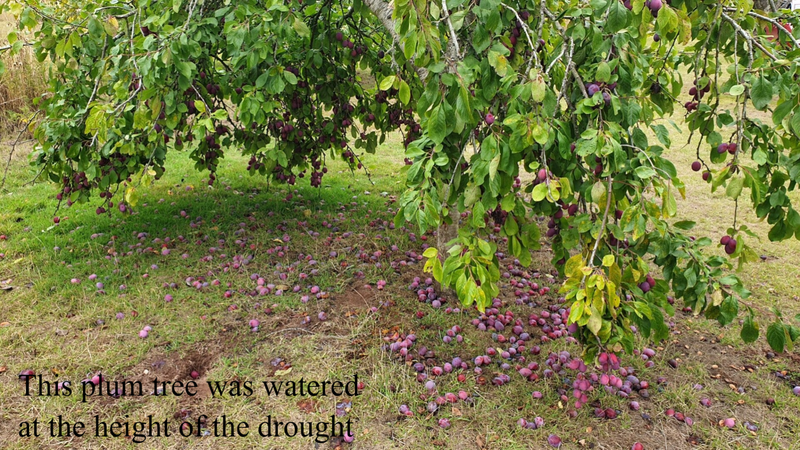
2. Have trees have coped with the drought
The grass has completely disappeared except for a few places where there is considerable shade. This has resulted in trees not having to compete for water and nutrients. Although the drought has clearly stressed a lot of trees they have survived apart from a few. I've watered those trees that were clearly struggling but the majority have produced bumper crops.
LEFT This plum tree was overwhelmed with fruit and required much of the fruit to be removed from sagging branches. However the fruit rotting on the ground can only improve soil organic qualities.

RIGHT broken branches is common this Summer. All the fruit trees have overproduced and suffered some damage. The rate of growth outflanked me and although I thinned some trees out there was just too much for me to do alone.
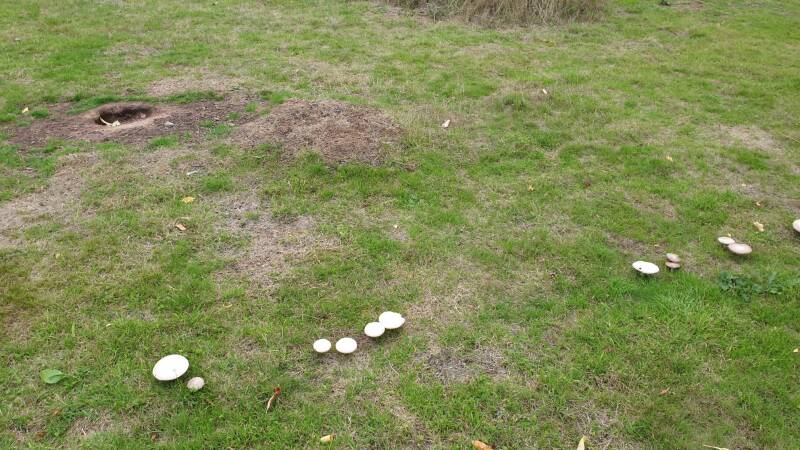
Many of the forest trails became extremely dry with early leaf fall. When the rain returned in September the fungi have exploded with fruiting bodies. In the picture above an you can see an active rabbit area with fungi creating trails of fruiting bodies below. These I think are common field mushrooms and edible.

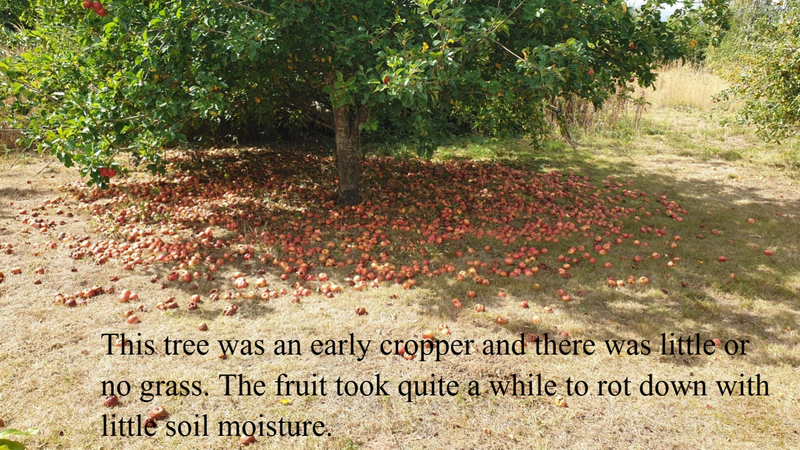
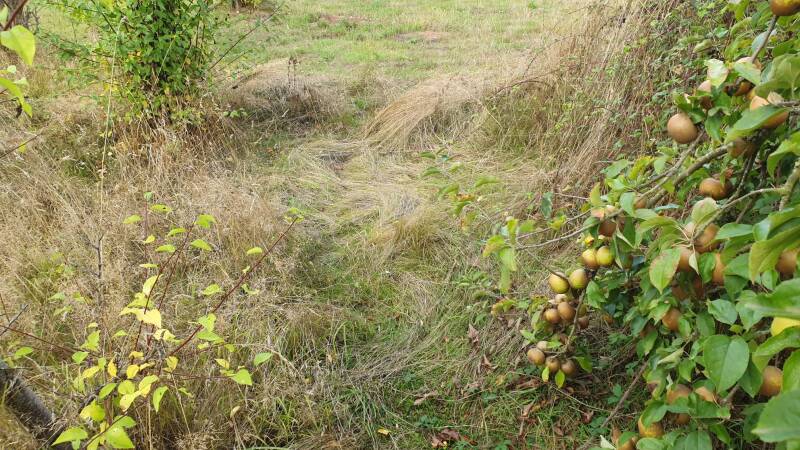
3. How has this Summer impacted on biodiversity
Rabbits have flourished and have been very active all Summer. Bird population has definitely dropped and is under evaluation. More will be clear over the Winter as it relatively easy to compare last years species (See Winter bird spotting 24/25).
Second badger set has now been established and a camera is to be set up to get some snapshots. Generally wildlife seems stable apart from a lot more ladybirds and very few aphids. This is however before appropriate observations over the next few weeks are carried out.
This sheltered spot is being used by early morning mystery animals
The sun shines here first thing and there no obvious signs of who it might be. My money is on foxes. But it could be muntjac or other types of deer.
Wildlife camera has been placed in position. Watch this space
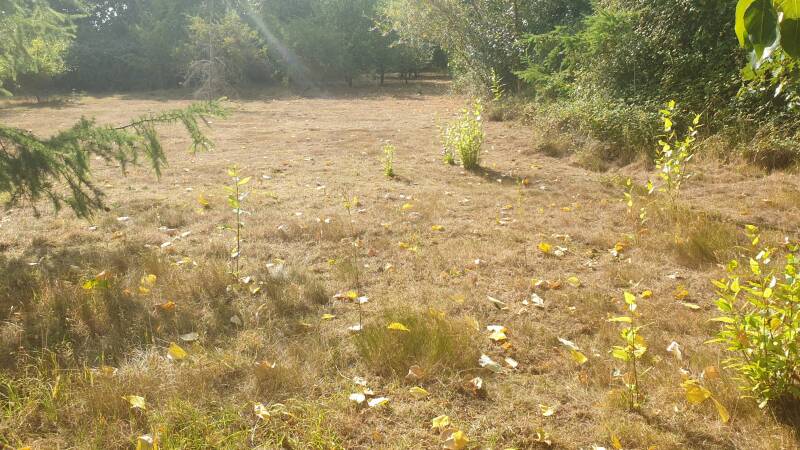

4. How can the site be more resilient and improved?
LEFT any areas without shade were devoid of grass and meadow flowers carefully established over many years. At this point I have no evidence of how this will impact on soil biodiversity and long term conservation efforts. It is clear however that open areas are likely to loose more moisture than a protecting leaf canopy covering most of the soil. At least some of the daylight hours anyway. Resilience enhancement might mean planting trees in these open areas.
I plan to incorporate fig trees and have invested in grape vines for next year in areas like this. More to follow.
In this picture moles were active where some watering took place for struggling apple trees. The rabbits joined in the soil management where soil had been loosened by moles. The result is equivalent to digging around the base to remove grass and aerate the soil.
To improve soil structure using nature is win win for me.

Three attempts all abandoned to dig into a bank. The soil was easy to remove on the surface here but the underlayer was hard clay and after the drought mechanically tough. Rabbits are opportunists and will dig until they find the best conditions for burrows.
Have rabbits and moles improved resilience? What do you think?
I have noticed that where there has been ground cover with structures like sheds, wood stores and general human covering the result has been adjacent trees flourishing particularly well. Also closing the tree canopy has had the same effect on general tree health and productivity. On a relatively small site of 5 acres open ground is at a premium and I want to maintain as much as possible. I've also found my wood cutting zones from summer and winter trimming can also protect the ground.
The site is quite wind resilient in most places due to planting of poplars and European Larch that are very large, now most over 10m and some 20m plus. Bramble zones also help with both ground cover and wind protection.
My plan is to intersperse some open areas with young trees including fig trees recently acquired.
BELOW Early Summer shows and abundance of fruit and healthy trees. However fruit trees went into overdrive and produced too much fruit resulting in many branch breakages.








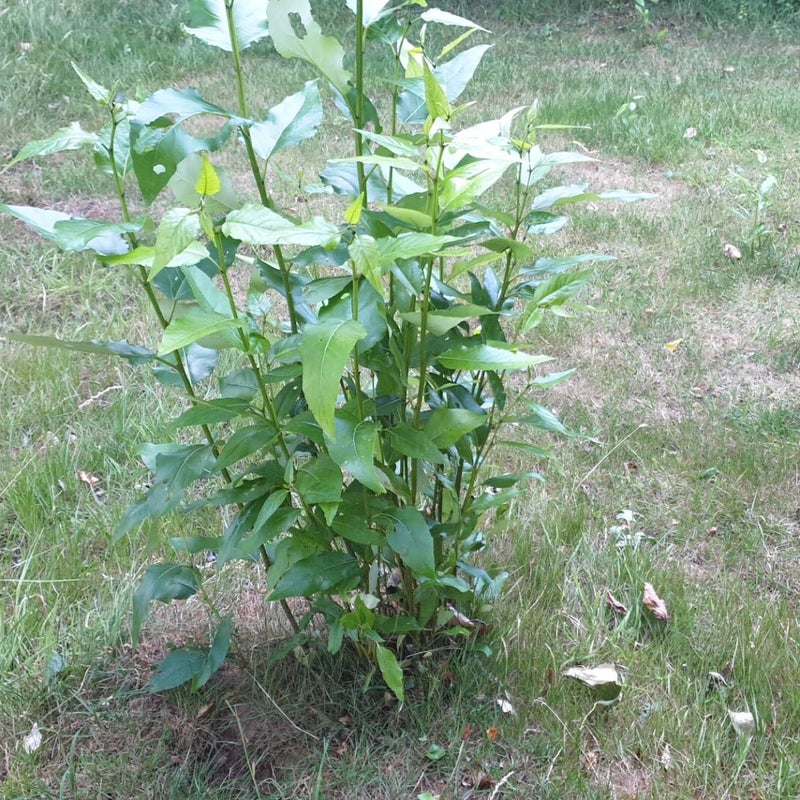



Broken branches from high yields will be a problem this year although I'm not complaining about the abundance of fruit. Also strong sunshine with drought conditions has resulted in grass being replaced by thistle which is always ready to take advantage of any space.
Walnut trees seem very happy with conditions and there are a lot of nuts on the trees. It has taken 15 or more years to produce the yields seen this year. They are spread around the whole site and are always the last to produce and lose their leaves. The nuts should be harvestable in Autumn.
Research hints that the mystery tree is cherry plum. It is often used as rootstock as it is hardy and vigorous (page 2)


The cherries this year are the best I've seen and trees that seemed to be struggling have produced excellent fruit. They are delicious in flavour and you can choose sweet or sour - the darker they are generally means sweeter. There are plenty for the bugs and the hoverflies in particular are doing very well. Their larval stage feeds on aphids and their abundance is a sign of ecological balance.
Bees are enjoying bumper harvest this year and can definitely be considered winners. The general research tells us that bees visit about 5000 different blossoms every day. Judging by the speed of these two above it might be even more.
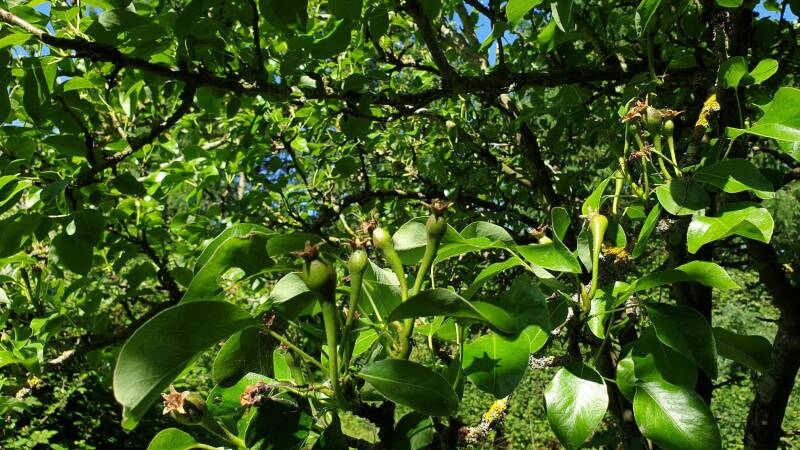

The picture directly above shows pear fruit set or the transition from flower to fruit. The wildlife walk above right is starting to get interesting with a variety of insects emerging. More on the species to follow.

The blossom this Spring can only be described as exceptional with dry sunny weather enhancing the potential for insects to pollinate and improve yields of fruit this Summer. I am waiting for the next weather event though before I count my apples. I consider current water levels to be in drought mode despite some recent heavy rain. According to the BBC's Newsround this year has seen signs of blossom a month earlier than usual in February (https://www.bbc.co.uk/newsround/68447182). My blossom is generally late I think due to the heavy clay soil retaining cold Winter temperatures. However this years peak is about 2 or 3 weeks earlier than usual.


Pond restoration update - May 2025

Left - The two tier pond leak has been successfully diagnosed after a considerable amount of work (see below). Two concentric holes interestingly the same depth suggest internal damage when the water level dropped. Both holes being created when the water level was the same height. If it was moles digging from the outside I would expect there to be some variation with depth. Rats are the most likely based on the size of the holes.
My plan is to repair these holes and see if the problem is solved. Alternatively a new membrane might be the sensible. I am open to suggestions info@five-acres-forest-school.org.uk.
If you look carefully you can see small semi circles in the membrane possibly matching the mouth parts. This hole would mean water level would stabilise and leave the leaf layer for camouflage.

First observation last month below - Feb 2025
This two section pond has developed a leak and will need some work. A neighbouring pond is full of frogs looking for a new home. The challenge is to repair the membrane without impacting too much on the organisms that live there. I will keep refilling and hope organic debris will accumulate around the damaged area and prevent excessive water loss. I will keep you posted.

Soil moles and rabbits
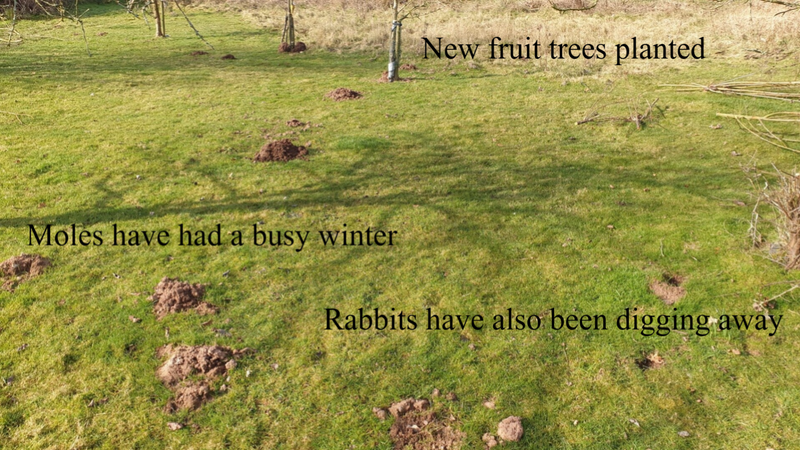
LEFT AND ABOVE Aerating clay soils usually involves mechanisation or chemicals but the tools of nature can do the job for us. The challenge is maintaining access after the rabbits and moles have worked so diligently. In this case for the newly planted apples and pear trees shown in the picture above the grass needs to be kept short for them to survive and flourish. Scything can be useful but short grass does require the use of our mechanical technology EG a mower.
A large orchard can be grass managed with sheep and also damaged when they eat the leaves of new and low growing saplings. This will be a the first sheep free year to give the new saplings a good start. They are currently on holiday with a local farmer.
Established fruit trees can dominate and hog the available sunlight and reduce grass growth beneath them when planted carefully. Newly planted fruit and nut trees however need some help when they are young. Saplings often die in hot Summers and especially when grass robs them of water and nutrients.
LEFT The grey willow provides crucial early spring foraging for bees providing nectar and pollen. A tree that provides excellent wood for weaving baskets and even furniture to the skilled craftsmen or woman.
The flowers are known as catkins with the long stalks being male and the short stalks with a green tinge being female.

New wildlife hotel opening soon. More layers will be added over coming weeks/months to accommodate emerging insects and animals. I am hoping this transitional approach will encourage greater biodiversity. If I build it up in one go it's likely to have less types of species. Nature builds slowly and I intend to emulate this as best I can. Besides I want to take as many materials from nature as possible and they are seasonal. These materials are definitely natural but man made in their construction.

Peacock butterfly using sun's energy to warm up. One of the first to emerge after Winter and the first i've been able to photograph.

One of last years wildlife dens has been claimed by as yet unknown creature. The layers of leaves and branches could house a hedgehog.
Spring is breeding time for frogs and they are both vocal and active

The frogs are camouflaged by the duckweed and in this case a wooden frame under which they hide if they detect predators.

Wasps have scraped off wood fibres to build new nests, this is most prevalent in April. This kind of activity is found on old dead trees especially. You can see the scrape marks where the bark has peeled away. I leave dead trees as long as possible to provide the raw materials needed by wildlife.
Wasps are an essential part of orchard ecology playing an important role in pollination and the removal of tree damaging insects.
The adults feed mostly on the rotting fruit found on the ground and feed insects to their young.
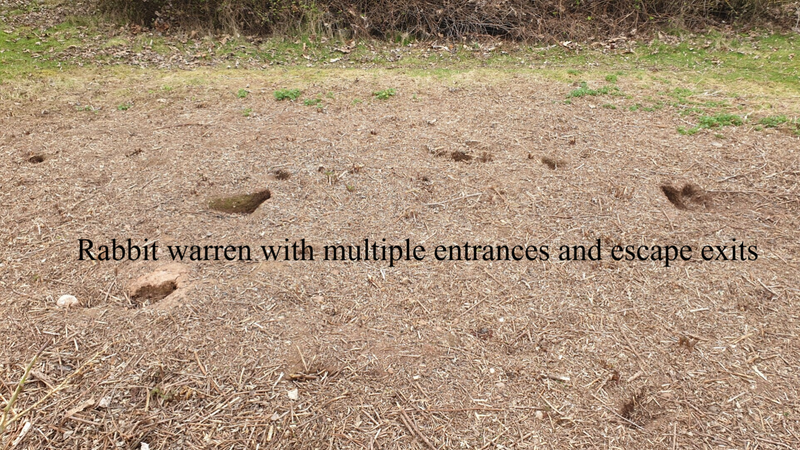
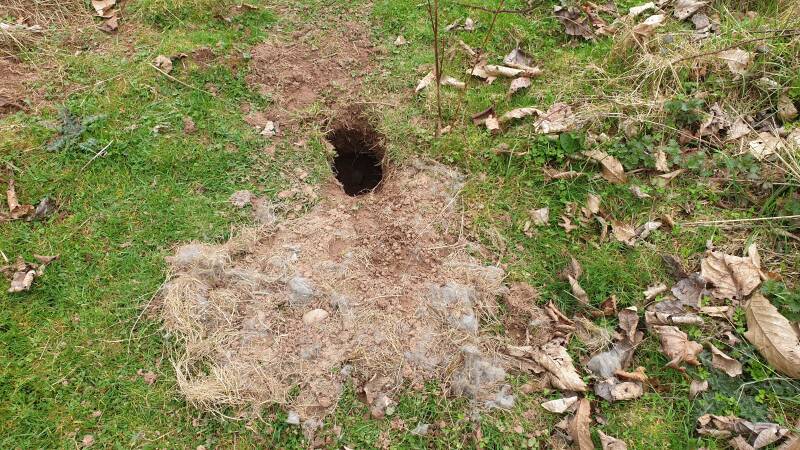
The rabbit holes are numerous where some bramble has been cleared and this and other holes are all active. Bramble was cleared because it was overwhelming the fruit trees near it.
Bramble is an important habitat and food source for nature but can overwhelm other plants to the detriment of biodiversity.
The grey and silvery hairs and the size of this recently dug hole suggest a badger(s) has moved in. This is potentially not entirely positive as they predate on hedgehogs which I have been keen to establish at Five Acres.
As omnivores they will eat fruit and a range of small mammals including rabbits. I just hope the site and surrounding area provides enough nutrition for them to not threaten the population of voles and other small creatures like dormice.
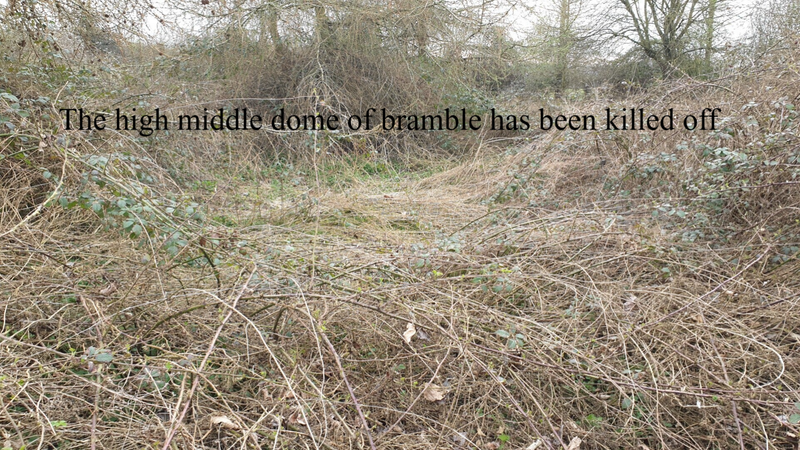
The above picture shows what was an impenetrable dome of bramble now with the middle missing. I have not observed escaped goats from neighbouring farms on the site, or wild ones which according to my research are the only animal that would eat this spiky and tough plant. Muntjac are possibly responsible but again I have not seen them. My sheep will eat the leaves but stay clear of the thorns so they are not to blame.
My theory is the root structure has been nibbled away at by rabbits burrowing underground while creating a network of warrens. One of the pictures above shows quite a few rabbit holes under the recently removed bramble but this bramble was high and rounded without the middle missing or collapsed middle.
The fact of the matter is it's actually a bit of a mystery. Please feel free to get in touch if you have any ideas.

Rabbits have helped keep the grass manageable over the Winter. Its short enough to cut in the Spring and will enable wild flowers to flourish with rabbits feasting on the surplus.

The picture above shows the bark stripped by both Muntjac and rabbits from tree trimmings. Reducing root stock growth is an essential task for the fruit trees. A lot of my rootstock is Blackthorn which can outgrow the less vigorous fruit tree like apple or pear which are grafted onto the root .








